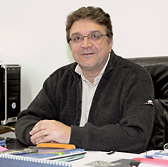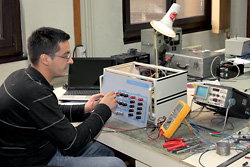Science and Economy
DR DRAGAN KOVAČEVIĆ, DIRECTOR OF ELECTRO-TECHNICAL INSTITUTE ”NIKOLA TESLA” IN BELGRADE
Development, With Respect for Tradition
Based on the strategic study aimed at solving the problem of reactive energy, for example, the Electric Power Distribution of Serbia saves tens of million of euros every year!... Serbian power distribution is based on the sparkling tradition of Tesla and Pupin. It is quite realistic and reasonable to have this as one of the key Serbian national brands, a strategic stronghold, powerful argument. Is that enough?
 Nobody in the world, no institution, company, product such as, for example, recently built electric car ”Tesla”, does not have a written approval of the supreme genius Nikola Tesla to carry his name – except Belgrade Electro-Technical Institute ”Nikola Tesla”. That approval was given by Tesla in 1936, in a telegram sent to engineer Slavko Bokšan, founder of the Society for the improvement of scientific and technical culture ”Nikola Tesla” (1935). Bokšan notified Tesla on the establishment of the Institute and asked for his permission to name it after the great inventor. In his telegram, among other things, Tesla wrote: ”I fully agree, because I have seen proof of it, judging by similar experience from America, that the Institute will bring great benefits…” Nobody in the world, no institution, company, product such as, for example, recently built electric car ”Tesla”, does not have a written approval of the supreme genius Nikola Tesla to carry his name – except Belgrade Electro-Technical Institute ”Nikola Tesla”. That approval was given by Tesla in 1936, in a telegram sent to engineer Slavko Bokšan, founder of the Society for the improvement of scientific and technical culture ”Nikola Tesla” (1935). Bokšan notified Tesla on the establishment of the Institute and asked for his permission to name it after the great inventor. In his telegram, among other things, Tesla wrote: ”I fully agree, because I have seen proof of it, judging by similar experience from America, that the Institute will bring great benefits…”
Then, in 1936, on May 28th, at Kolarac University, a ceremonial academy was organized to celebrate the establishment of the Institute along with the 80th birthday of Nikola Tesla. It gathered the most eminent representatives of scientific and cultural life of the Kingdom of Yugoslavia. Professor Bogdan Gavrilović, president of the Royal Serbian Academy of Sciences, had the honor to announce the establishment of this Institute. He concluded his long speech, in which he praised not only Tesla, but other Serbian innovators, scientists, those who propelled the progress of the country, with words: ”Let this Institute develop, through centuries, the fertile and beautiful thoughts of Nikola Tesla, to the glory of science and to the glory of the person whose eminent name it carries!”
Institute ”Nikola Tesla” entered its 75th year of existence. Today, just like then, it is the pioneer of modernization. During numerous social transformations, other successful institutes sprouted from it: Institute ”Mihajlo Pupin”, Institute ”Jaroslav Černi”, Institute ”Milan Vidmar” (Slovenia), Institute for Power Distribution (Croatia). The Museum of Nikola Tesla has also developed from this Institute.
STUDIES, RESEARCH, PRODUCTION
– The system has changed, everything is decentralized, from the manner of operation to the ”Electric Power Distribution of Serbia” itself – says electrical engineer Dr Dragan Kovačević for National Review, the first man at the Institute ”Nikola Tesla” – And every company (hydro power plants, thermal power plants, distribution companies...) has their plans for development, their research. In departments for investment and production, however, there are centralized services and we cooperate with them like we used to. Our Institute was created and is still working today as an integral part of the electric power distribution system. EPS is our strategic and the biggest business partner. We make almost 60 percent within this cooperation.
Some institutes are preparing studies, others are involved in research (like the Materials Testing Institute), and some (like ”Pupin”) are producing high technologies. Institute ”Nikola Tesla” has kept all these elements of scientific and research work: studies, research, monitoring and diagnostic, as well as production of devices. In the structure of our income, one third comes from study activities, one third from testing in real network, and one third from the production of high technology devices.
– Through a strategic study we have solved the problem of reactive power, which is necessary for the production of active power. Reactive power is creating loss in the system, it reduces its efficiency proportionately – adds Dr Kovačević. – We have researched its effects on all voltage levels, from 400 kilovolts to the consumer network. We have reduced losses, production costs, and the savings of ”Electric Power Distribution” amount to dozens of million of euros annually. The entire team of experts was involved in this study, and the project was led by Dr Miloje Kostić and Saša Minić, Director of the Centre for Electric Power System. We collaborated directly with colleagues from the ”Electric Power Distribution”, who had identified that problem themselves, defined it and initiated its solving.
A good example of how much it is possible to save through research work and knowledge. We are currently working on the study of primary, secondary and tertiary regulation of voltage and frequency in the power system. Serbian power distribution system is a part of the European one, and power quality standards must be complied with. This is regulated automatically, from one centre, from where instructions for corrections are distributed. The system must operate optimally, must be stable, and all parameters must be within the prescribed limits.
IN ACCORDANCE WITH WORLD STANDARDS
 The second group of big projects implemented by Institute ”Nikola Tesla” includes testing, monitoring and diagnostic of big transformers and generators in Serbia and the surroundings (Srpska, Montenegro, Macedonia). The second group of big projects implemented by Institute ”Nikola Tesla” includes testing, monitoring and diagnostic of big transformers and generators in Serbia and the surroundings (Srpska, Montenegro, Macedonia).
– This is conducted by our testing laboratoty. We periodically diagnose the condition of a machine, determine for how long it can keep operating like that, whether a capital overhaul is necessary... Decisions related to what needs to be one are made in power plants, based on opinions of our experts. Of course, we listen to opinions of other experts, like mechanical engineers. Our laboratory is accredited by the Accreditation body of Serbia. That means that we comply with standards, use calibrated equipment, with personnel who are qualified and authorized to perform such work. We work in accordance with world standards, just like in USA, Russia, Japan... We are currently testing a new class of transformer oils for French company ”Areva”.
At the Institute ”Nikola Tesla”, says our host, they make specific devices, rare in the world, such as excitation systems in power plants. They also produce (in cooperation with the Faculty of Electric Engineering) electrostatic filters used in collection of soot particles, in order to decrease emission of hazardous matter in thermal power plants. These filters meet world standards, because they retain all particles above 50 milligrams.
– We work not only for the ”Electric Power Distribution”, but also on state projects (Ministry of Energy, Ministry of Science and Technology). We cooperate with companies, issue attestations to private entrepreneurs (a product quality certificate that is very important for them) – says Dr Kovačević. –
Electricity and power distribution system in Serbia are resting on the tradition of Tesla and Pupin, says the first man of this institute. The ”Electric Power Distribution of Serbia” is a very strong system, well designed and extremely important. And it should be, quite realistically, one of the key Serbian national brands, strategic stronghold of Serbia, something that makes us recognizably the strongest in the region.
– We have potential, know-how, qualified people. Appropriate industry, and there is no reason to have these activities conducted by, or to have the ”Electric Power Distribution” run by foreigners. Certainly, we cannot be strong in everything, but in electric power distribution we can. If we gathered true elite, science and companies in the creation of such a brand, an excellent work would be done without any doubt. Local industry would have great benefits from that too. If we sold the ”Electric Power Distribution”, the acquired funds would be insufficient (and quickly spent), and control over one vital national resources would be lost. Every reasonable and rational state is always trying to hold on to such resources.
***
Museum
Since 1939, Nikola Tesla was receiving pension from the Kingdom of Yugoslavia. Since he did not want to receive it directly, he received it from the Institute that carried his name.
After the death of the great scientist in 1943, in accordance with his will, his distant cousin Sava Kosanović transferred Tesla’s legacy to Belgrade. When the administrative procedure was completed, big crates that arrived at the Institute were filled with numerous manuscripts, but also with hats, neckties, gloves… At that moment it was decided to establish Nikola Tesla Museum. Until today, it has been one of the most frequently visited museums in Belgrade.
***
Organization
– Work of the Institute is organized in research centers: Center for Electric Power Systems, Center for Automatics and Regulation, Center for Electric Power Facilities and Center for Electric Measurements – says Dr Dragan Kovačević. – There is also Laboratory for testing and calibration, Production Workshop and Common Affairs Department. Almost 90 percent of employees have university degrees. Among 120 employees, 14 of them have PhD and 10 have MA degrees.
|
